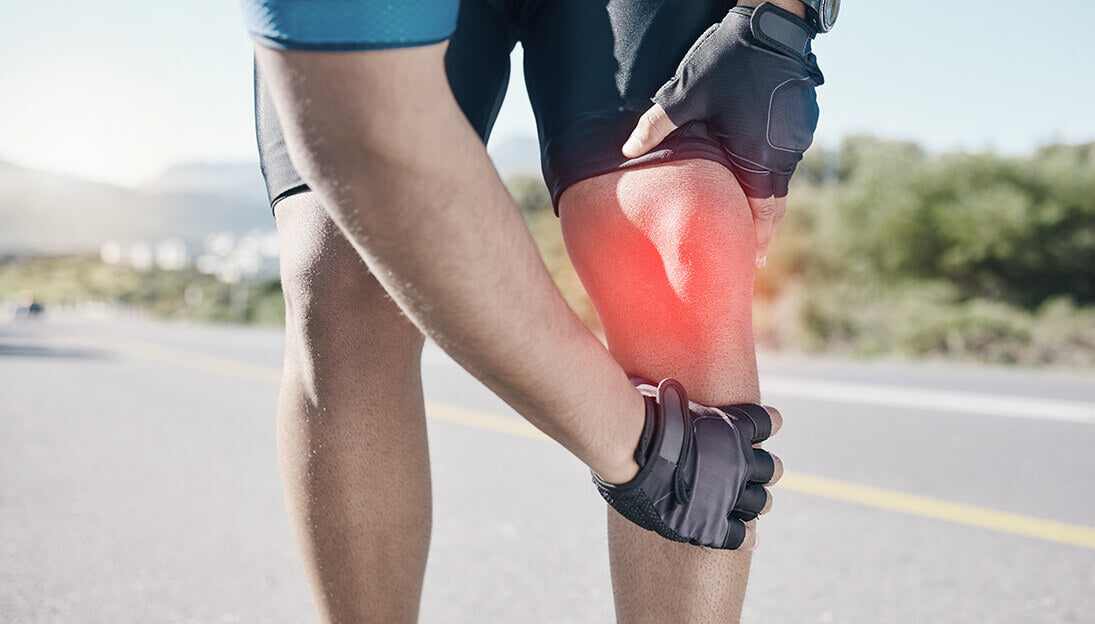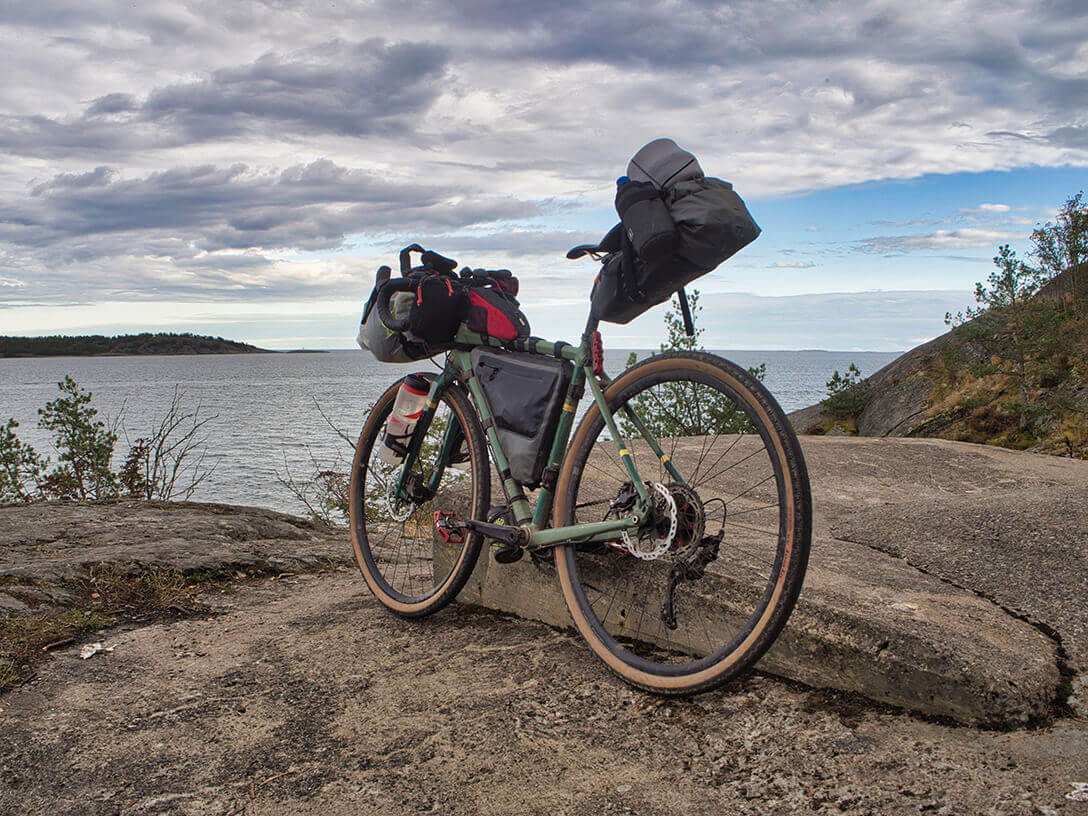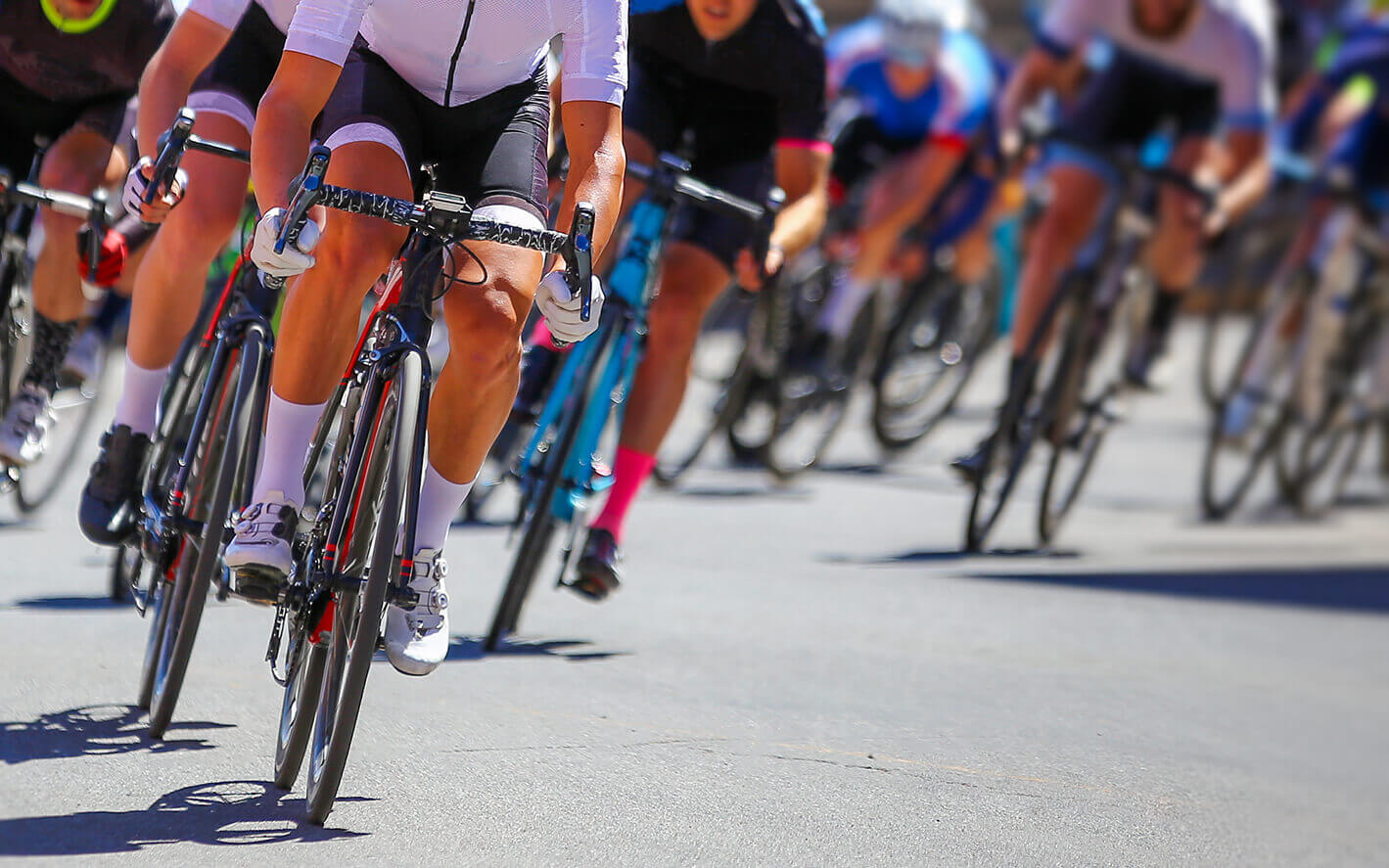If you’re grappling with pain in knee when cycling, you’re seeking answers and relief. This guide cuts through the complexity to help you understand the common causes and equip you with prevention strategies. Without giving away too much, we’ll explore how correct bike fit, training adjustments, and targeted exercise can help alleviate your discomfort—a promise to put you back in the saddle with confidence.
Key Takeaways
- Cycling knee pain is common and can manifest in various forms such as anterior, posterior, medial, or lateral knee pain, with specific causes and symptoms related to the positioning and movement within this complex joint.
- A professional bike fitting that includes adjustments to saddle height and position, pedal and cleat alignment, as well as crank length and Q-factor, is crucial for preventing and addressing knee pain in cyclists.
- Effective management and prevention of cycling knee pain involve a combination of proper training habits with gradual mileage increase and warm-up routines, addressing muscle imbalances through exercises and stretching, and using techniques like foam rolling and targeted stretches to alleviate pain.
Understanding Knee Pain in Cycling

Cycling knee pain is a widespread issue, with studies documenting rates from 36% to 62% for amateur cyclists and 23% for professionals. The knee, a complex joint comprising the femur, tibia, and patella, is a pivot point of cycling mechanics. Cycling-related knee pain can manifest in various ways depending on the location and cause, with the most common types being:
- Anterior knee pain
- Posterior knee pain
- Medial knee pain
- Lateral knee pain
Symptoms of knee pain, which may indicate that your knees hurt, often include:
- Redness
- Swelling
- Warmth
- Weakness
- Instability
- Audible popping or crunching noises
The pain can be persistent, leaving you with a nagging feeling each time you pedal. However, there’s no need to lose hope! The journey to relief begins with identifying the root cause of your pain.
Anterior Knee Pain
Let’s start with anterior knee pain, which is synonymous with patellofemoral pain syndrome or runner’s knee. This type of pain often arises from overuse injuries at the front of the knee, where quadriceps muscles connect to the shin bone via the patella, exerting forces across the patellofemoral joint. When you experience a stabbing pain at the front of your knee, you’re likely dealing with anterior knee pain.
An imbalance between the vastus medialis oblique (VMO) muscle and the lateral thigh muscles can lead to this type of pain. Add tightness in the quadriceps, which are connected to the thigh bone, to the mix, and the pain intensifies. Not to worry, though; the right bike fit, especially the proper saddle height, can help prevent anterior knee pain.
Moreover, relieving anterior knee pain associated with cycling can be possible with stretches focusing on the quadriceps, hip flexors, and glutes, which are commonly tight in cyclists.
Posterior Knee Pain
On the flip side, we have posterior knee pain. If your saddle is too high, you might be causing hamstring tightness and overextending your knee, leading to pain at the back of the knee. Symptoms of posterior knee injuries often include:
- Pain
- Swelling
- A feeling of instability
- Difficulty walking
Keep in mind that it’s imperative to consult a medical professional, particularly if you observe symptoms such as a bulge of synovial fluid behind the knee, which can be misinterpreted as injury-related posterior knee pain. Proper diagnosis is essential in managing knee pain from cycling.
Medial and Lateral Knee Pain
Now, let’s shift our focus to medial and lateral knee pain. You might have heard of the iliotibial band syndrome, an inflammatory condition known to cause lateral knee pain in cyclists. If you’re experiencing pain on the outer side of your knees, it could indicate this syndrome. Acute management of this condition involves rest, ice, and anti-inflammatory medications to reduce inflammation and pain.
Rehabilitation should begin with stretching, particularly of the iliotibial band, followed by strengthening exercises aimed at the gluteus medius muscle.
The Role of Bike Fit in Cycling Knee Pain

We’ve acknowledged that knee pain is a common issue for cyclists. But what’s the solution? A significant aspect is the fit of your bike. That’s right! A professional bike fitting is crucial for a pain-free riding experience and for preventing knee pain in cyclists. During the fitting process, special attention is given to riders with anterior or lateral knee pain to ensure proper adjustments are made.
The settings of your bike fit impact kinematics, kinetics, and muscle activity around the knee, which are key areas to consider when addressing knee pain. Misalignment and improper adjustments of cycling equipment can contribute to the development of knee pain. Therefore, pay attention to your body’s signals and think about getting your bike fitted if your knee pain continues. Regular check-ins with a bike fit specialist are recommended to maintain proper alignment and prevent recurring knee pain.
Saddle Height and Position
Let’s get into the particulars of a bike fit, beginning with the saddle height and position. Improper saddle height can cause several types of knee pain. Here are some key points to consider:
- A saddle that’s too high increases pressure on the knee cap, leading to pain
- A saddle that’s too low can cause pain in the front of the knee
- A saddle that’s too far forward can cause ITB pain from friction on the epicondyle
- A saddle that’s too far back can cause hamstring pain
It’s important to find the right saddle height and position for your body to avoid these issues and ensure a comfortable ride.
Moreover, the saddle position, including the fore/aft placement, influences knee pain, with a too far forward positioning causing stress on the patellar and quadriceps tendons. Incorrect saddle positions such as the saddle being too high can lead to ‘elliptical knee tracking’ and ‘knees-out’ tracking, both potentially causing knee pain. So, adjusting the saddle height by small increments and assessing the impact over multiple rides is crucial for determining the optimal position to alleviate knee pain.
After adjusting the saddle height, test rides and possible further fine-tuning of the saddle position are recommended to confirm the absence of knee pain.
Pedal and Cleat Alignment
Moving on, let’s discuss the alignment of the pedal and cleat. Proper cleat and pedal alignment minimizes rotational stress on the knee joint, which is crucial for preventing long-term irritation and injury. Medial and lateral knee pain, as well as pain at the front of the kneecap, can be directly linked to cleat positioning, which if not aligned properly can stress knee ligaments and the patellar tendon due to improper stance width and cleat angle.
Adjustable cleats, such as Speedplay, offer the following benefits for cyclists:
- Multi-axis adjustments
- Customizable float degrees
- Fine-tuning of cleat positioning to align with individual biomechanics
- Reducing the risk of knee pain
Individual foot biomechanics, such as a supinating foot that rolls outward, can affect knee alignment while cycling. Cleat adjustments, including forefoot wedging, can help correct these issues and prevent cycling-related knee pain.
Crank Length and Q-Factor
Finally, let’s consider the length of the crank and the Q-factor. Crank lengths that are too long can cause excessive knee flexion at the top of the pedal stroke, increasing strain on the patellar and quadriceps tendons, potentially leading to knee pain. Shortening crank length reduces the amount of knee flexion during the pedal stroke and is effective in addressing pain under the kneecap.
Riders often report less knee and hip pain with shorter crank lengths due to a reduction in the angle of flexion at the hip and knee. The choice in crank length is influenced by personal preference, leg length discrepancy, and leg length, with some riders preferring shorter cranks for relieving knee pain.
An incorrectly matched Q-factor can lead to lateral knee pain if too narrow, or medial knee pain if too wide, by introducing improper forces on the knee.
Training Habits and Knee Pain

Let’s now turn our attention to training habits. A sudden increase in cycling mileage or intensity can lead to ‘spring knee’, a form of tendinitis that causes knee pain. Cyclists are advised to increase their mileage by no more than 10% a week to prevent training-related knee pain.
Starting with lower mileage and building up slowly is the recommended approach for cyclists to protect their knees from injury. Also, a proper warm-up for cyclists should last at least 15 minutes of moderate spinning to prepare the knees for the ride.
Gradual Mileage Increase
Base training is the foundational methodology for gradually increasing cycling mileage, typically involving cycling at a moderate intensity of 55-70% of max heart rate, which facilitates extended, steady rides. This approach provides a solid foundation for your cycling training, preparing your body to withstand higher intensity sessions, and helps you maintain average speed for longer hours.
If you want to use apps on your phone such as Zwift or Strava while you are riding, be sure to use a secure phone mount so you can keep your phone within view on your ride. StrideCharge offers a secure phone bike mount that also includes wireless charging, so you won't have to worry about your phone battery dying during your ride.
Proper Warm-Up and Cool-Down
Proper warm-up and cool-down routines are just as essential in your training habits. Starting interval training sessions with a few minutes of warm-up is crucial to prepare the body for increased cycling mileage.
Cooling down with 4 or 5 minutes of easy pedaling after riding aids in transitioning the body back to its normal state and mitigates muscle stiffness.
Avoiding Overuse and Overtraining
Avoiding cycling overuse injuries, such as knee pain, is crucial in your training habits. To avoid overuse and overtraining, training smartly is important, which includes taking breaks when tired and ensuring that base training volume and intensity are adjusted based on fitness levels.
Including at least one recovery day per week in a cyclist’s training schedule is essential to ensure proper rest and prevent overuse injuries.
Addressing Muscle Imbalances

Addressing muscle imbalances is a significant part of managing knee pain. Cyclists may experience knee pain due to muscle imbalances such as weak glute muscles, possibly leading to abnormalities in knee movement. Muscle imbalances like weak gluteus medius muscles, combined with tight lateral thigh muscles, can result in conditions such as patellar compression syndrome and iliotibial band syndrome in cyclists.
The gluteus medius muscle is crucial for stabilizing the hip during cycling and preventing knee pain, and exercises that strengthen this muscle may aid in correcting imbalances. To prevent cycling-related knee pain, it is essential for cyclists to have strong glutes, abs, and core muscles, as imbalances in these areas can lead to increased stress on the knee.
Strengthening Weak Muscles
Strengthening exercises can greatly enhance knee stability, a key factor in managing and preventing knee pain in cyclists. Specific strengthening exercises include:
- Lunges and squats, which activate glutes, quads, calves, and hamstrings
- Calf raises, which improve ankle plantarflexors
- Single-leg deadlifts, which address muscle imbalances in the hamstrings and hips
Core exercises like planks and variations enhance stability and efficiency, elements that are not fully developed through cycling alone.
Stretching Tight Muscles
Frequent stretching enhances:
- Blood and oxygen circulation to the muscles, facilitating cell growth
- Boosting organ functionality
- Preventing tissue degradation by stimulating the production of tissue lubricants
- Organizing cellular structure
Stretching can have numerous benefits for your body.
Tight hamstrings can shorten and cause pain around the knee, making hamstring stretching essential for managing posterior knee pain. On recovery days, light yoga or mobility work focusing on:
- hip flexors
- hamstrings
- glutes
- calves
is beneficial, in addition to chest stretches to maintain overall body balance.
Incorporating Cross-Training
Cross-training enhances cyclists’ overall fitness by addressing performance limiters and offering protection against potential injuries. Participating in activities such as running, hiking, and weightlifting can improve bone density for cyclists, countering the low-impact nature of cycling.
Regular incorporation of cross-training into an exercise routine is crucial for cyclists to achieve tangible progress and reduce the likelihood of severe soreness.
Techniques for Alleviating Knee Pain

While prevention is always better than cure, sometimes knee pain can sneak up on you, making you feel like your knee hurts. In such cases, various techniques like foam rolling and self-massage, targeted stretches, and ice and heat therapy can help alleviate the pain.
A dynamic bike fitting, combined with motion capture technology, can offer customized adjustments to relieve knee pain and improve knee extension in cyclists.
Foam Rolling and Self-Massage
Foam rolling is a form of self-manual therapy that targets soft tissues to facilitate myofascial release, using a cylindrical foam device to apply pressure. Setting up a daily foam rolling routine, devoting approximately 10 minutes to target tight muscle areas like quads, glutes, hamstrings, calves, hip flexors, and upper back, can significantly aid in reducing knee pain.
Targeted Stretches
Stretching after cycling reduces muscle soreness and stiffness by increasing blood flow to deliver nutrients and remove lactic acid, and also improves overall flexibility that is essential for optimizing performance. Stretching should be carefully timed, avoiding static stretches immediately after cycling and instead waiting at least three hours after cycling to prevent soreness; when stretching, each should be held for at least 20 seconds, with longer stretches of at least one minute recommended during rehabilitation or for effective muscle relaxation.
Ice and Heat Therapy
Ice and heat therapy can help manage inflammation, promote flexibility, and soothe discomfort associated with knee pain. Initially, it’s recommended to use ice on the affected area to address pain and reduce swelling; ice should be applied strategically to the painful region.
After the acute inflammation has subsided, heat should be applied for about 10 to 15 minutes to promote healing. Alternating ice and heat therapy, like a contrast shower with cycles of hot and cold, can aid in muscle recovery by managing inflammation and promoting flexibility.
Preventive Measures for Cycling Knee Pain
Preventing knee pain before it starts is the best approach. Regular bike maintenance, using supportive gear, and periodic check-ins with a bike fit specialist are some measures that can help in preventing recurring knee pain.
Regular Bike Maintenance
Routine bike maintenance, including checking tire pressure and brake pads, is key to preventing discomfort or knee pain from cycling. A well-maintained bike ensures a smooth ride and prevents unnecessary strain on your knees.
Use of Supportive Gear
Using supportive gear, such as knee braces, can alleviate knee pain for those recovering from surgery or experiencing knee weakness, reduce the risk of re-injury, and potentially increase a cyclist’s confidence post-injury or surgery. However, using the correct knee brace is crucial as an unsuitable brace can impair recovery and possibly lead to more damage.
Periodic Check-ins with a Bike Fit Specialist
Regular consultations with a bike fit specialist are advised to ensure correct alignment and prevent recurrent knee pain. These check-ins ensure that your bike fit remains optimal even as your fitness level and cycling technique evolve over time.
Summary
In summary, knee pain in cycling is a common issue that can be effectively managed and prevented. Understanding the types of knee pain, the role of proper bike fit, the importance of healthy training habits, techniques for alleviating knee pain, and preventive measures are all vital in your journey to a pain-free cycling experience. Remember, cycling should be a source of joy and fitness, not pain. So, take care of your knees and enjoy the ride!
Frequently Asked Questions
How do I stop my knees from hurting when cycling?
To prevent knee pain when cycling, adjust the saddle-pedal distance, check the saddle position, wear suitable cycling shoes, increase training gradually, warm up before cycling, and do stretching and flexibility exercises. Also, ensure your saddle isn't too low to avoid excess stress on the knee.
Is it OK to cycle with knee pain?
Yes, cycling is generally okay for people with knee pain as it is a low-impact exercise that strengthens the muscles around the knee and reduces pain.
What are the symptoms of bikers knee?
The symptoms of biker's knee include aching pain in the knee joint, tenderness when pressed, and pain increasing with exercise or activity. Malalignment of the patella can also contribute to these issues.
How do you fix anterior knee pain when cycling?
Foam rolling is one of the best ways to treat anterior knee pain. It improves blood flow, reduces tightness, and eases inflammation in joints and muscles. Try foam rolling two or three times a week to keep your quads and IT band healthy.
What are some causes of knee pain in cycling?
Improper bike fit, overuse, muscle imbalances, and sudden increase in cycling mileage or intensity are common causes of knee pain in cycling. Be mindful of these factors to prevent discomfort while riding.




Leave a comment
This site is protected by hCaptcha and the hCaptcha Privacy Policy and Terms of Service apply.